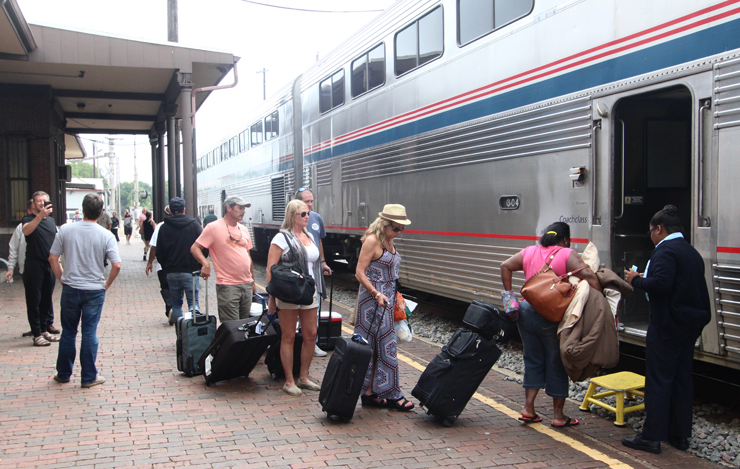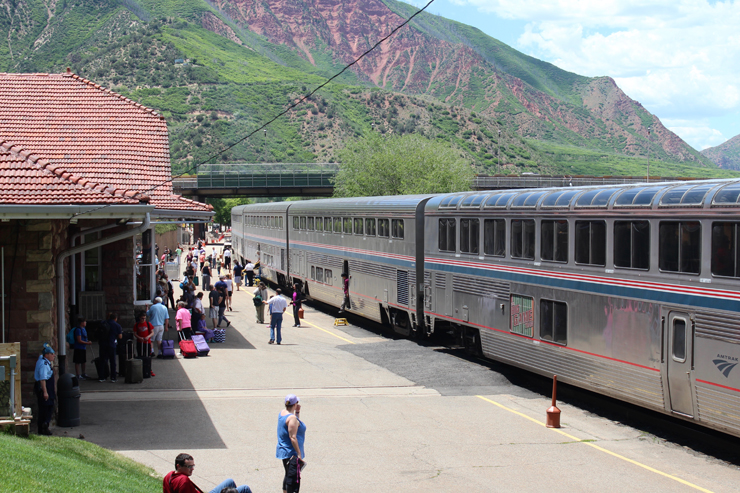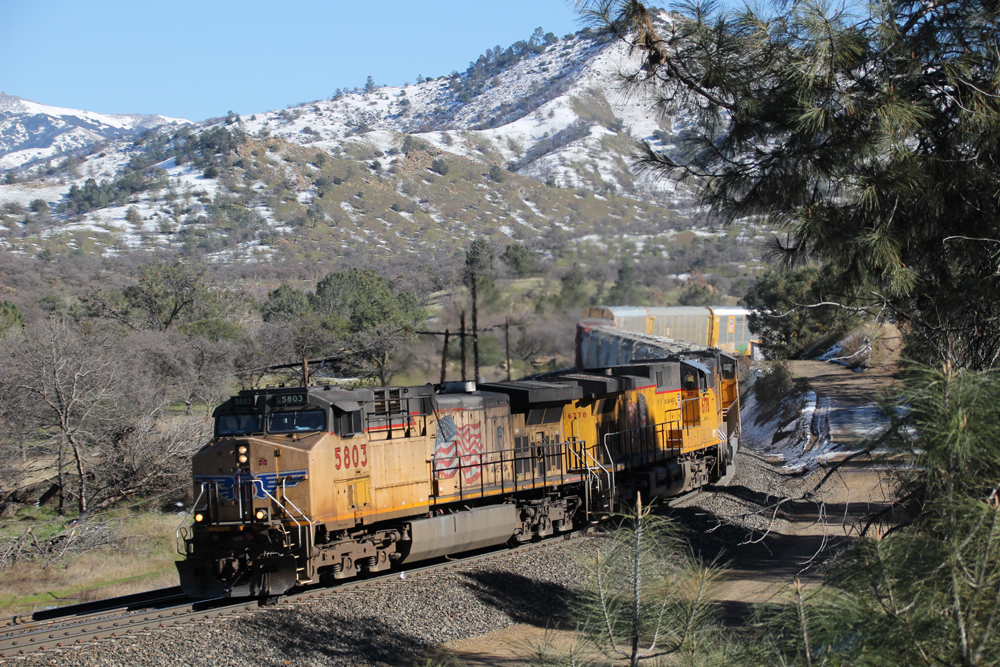WASHINGTON — More details have emerged from President Donald Trump’s proposed Amtrak cuts in the 2020 federal budget, which specifically target the elimination of long-distance trains. Meanwhile, Amtrak requested continued funding at 2018 levels.
The document released last week shows exactly how the administration would cut service to rural and medium-sized cities, many where Amtrak is the only public mobility available. Most observers believe the proposed cut of Amtrak’s annual appropriation to $936 million, from the $1.9 billion enacted by Congress in fiscal 2019, has no chance of being approved.
The budget would immediately remove funding for the long-distance network — itself an arbitrarily devised amalgam of 15 routes comprised of trains traveling over 750 miles defined under 2008’s Passenger Rail Investment and Improvement Act.
“The budget proposes that federal operating support for long distance routes would now be provided through the Restoration and Enhancement Grant program, not Amtrak’s annual grant, then phased out entirely,” the document explains on page 78.
The 2020 budget would create a transition plan in which the Department of Transportation, Amtrak, states, and local governments would “rationalize” the long-distance network “to more efficiently serve modern market needs as a series of shorter-distance, high-performing corridor services where passenger rail as a transportation option makes sense.” Low-population areas, it said, would be better served by other modes of transportation, like intercity buses.
The concept is exactly what Amtrak proposed in 2018 when it suggested replacing the Dodge City, Kan., to Albuquerque, N.M., portion of the Southwest Chief ‘s Chicago-Los Angeles route with buses. That rationale was soundly rejected by a bipartisan group of U.S. Senators from the affected states; furthermore, lawmakers appropriated $50 million to Amtrak specifically to pay for improvements on the route that the company refused to make until forced to do so after the budget bill passed.
Rail Passengers Association President and CEO Jim Mathews points out, “By moving long distance train funding to a competitive grant program — controlled by the White House — the administration gets to choose the winners and losers.”
Aside from dismissing transportation needs of rural America, rationale put forth in the budget document’s “justification” section fails to disclose other consequences, shortcomings, and flaws of eliminating the long-distance network:
— Infrastructure facility, station, and route costs now shared with Amtrak would now be the complete responsibility of the states, sharply raising their expenses. States would also lose connection revenue.
— Travel options provided by long-distance trains on state corridors such as Chicago-Carbondale, Ill., Chicago-St. Louis, New York-Buffalo, N.Y., and Santa Barbara-Los Angeles, Cal., would disappear. Coordination efforts between states have failed when the money ran out for both long-distance (the first New York-Chicago Lake Shore Limited) and regional services (three versions of the New Orleans-Mobile, Ala. Gulf Coast Limited).
— Adding frequencies on routes which “make sense,” as defined by the Department of Transportation, would require agreement with host railroads to protect their capacity with infrastructure improvements.
— “Loss per passenger” figures are listed for several long distance trains — while ignoring the revenue or passenger miles they contribute. As for “losses,” Amtrak has yet to provide Trains with line-item expense accounting data for the Southwest Chief that we asked for in connection with a cost allocation report [see “Amtrak’s money mystery,” January 2019 Trains].
— Saying that “only 12 percent of long-distance passengers are riding endpoint to endpoint, with most passengers traveling less than 500 miles” proves that category’s strength, not weakness. It means 3.97 million intercity riders (out of 4.51 million in 2018) used the overnighters to create their own “corridor” at an average ticket price of $107.72, compared with $33.79 for state-supported trains and $75.55 for Northeast Regionals.
If these Administration talking points seem familiar, it’s because they mirror the same language Amtrak senior management uses in its fiscal 2020 grant request, also released last week.
The “Amtrak Response to the Administration Budget” section (page 17), makes no attempt to discuss why a 52-percent cut to the company budget would be detrimental to all operations and put Amtrak even further behind in its state-of-good-repair backlog.
Instead, there’s this: “Amtrak appreciates the administration’s focus on expanding intercity passenger rail service to today’s many underserved cities and corridors across the nation. We believe a modernization of the National Network with the right level of dedicated and enhanced federal funding, would allow Amtrak to serve more passengers efficiently while preserving our ability to maintain appropriate (emphasis added) long distance routes.”
The fact that both Amtrak management and the Trump administration choose to gloss over challenges that help explain why they (incorrectly) charge Amtrak’s long-distance network “has not changed from its original iteration 40 years ago,” as the budget document claims, means lawmakers will have to fill the credibility gap in upcoming Amtrak reauthorization discussions.
In 2018, Senators on the Southwest Chief route became involved on behalf of their constituents. With all non-Northeast Corridor services affected, perhaps more legislators will decide to get involved.
















With such vast areas of the budget to cut or economize, Amtrak has always been a target since it came into being. Subsidies for the air industry are camouflaged. Is there a direct subsidy to United or American airlines. Of course not. Minor as it may be, Amtrak’s identity in the budget should be changed to passenger rail. With that change, Amtrak’s monoply should be broken up into at least two pieces. The NEC and everything else. This will probably not happen because the “Amtrak” subsidy also masks the true costs of providing rail services for all the highly political transit agencies in the region. Additionally, the railroads do not wish to deal with other qualified private rail operators that could take over from Amtrak. All other comments below are germane as well. Washington, D.C., we do have a problem when it comes to passenger rail and transit funding.
The fact is that if the current administration does not fund the Hudson tunnels a very large part of Amtrak’s corridor trains will be become useless, and the secondary impacts to all related infrastructure will far out cost the money to remake the tunnels. About the only people who might benefit from poorer Manhattan to the rest of the East Coast travel are those who own NYC real estate where even more people will then need to live. So killing long distance will take out the “National” in a national rail service an eliminate a nation constituency for Amtrak.
So much winning.
Without the LD routes to feed additional patronage into the state supported routes they will be competing for the same limited markets along with airlines, Megabus & the private auto (most choosing auto). These corridors will also be vulnerable to the changing political climate in the state(s) they serve making them an unreliable option for the traveler. Without the LD routes and the resulting shaky corridors that may exist the majority of the nation will not have access to passenger rail, perhaps its time to “kick it to the curb” including the NEC as the taxpayers have enough mouths to feed with the highways and aviation financial deficits.
And I like Roger William’s ideas. I’ve long had the thought that freight railroads could benefit by accepting the fact that Amtrak is not going away and work to make the best of it rather than trying to fight it all the time.
As long as passenger rail is funded by government and ultimately taxpayers, we are going to have this kind of problem. And no wonder. Taxpayers are concerned about how their money is spent, and rail promoters can tout the benefits while not actually having to pay their “fair share”. Everyone says it’s impossible to make rail pay for itself, but I’m not convinced that is actually the case. Because I believe this issue is so important, at the risk of violating a posting policy, here is a link to an interactive demonstration I created to try to illustrate this problem. I’m also exploring solutions.
http://tinyurl.com/y6t2laol
Mark, Since the private railroads are in business to make a profit,I think that they would know better than to totally price themselves out of the market. They can operate trains much more efficiently than Amtrak has ever been able to and the possibility of value-added express shipments that they were unable to bid for before, could keep the cost down considerably. Also,not having to pay for station facilities and upkeep would also help. The proper connections and marketing along with modern and eye appealing equipment just might do wonders for the bottom line. No railroad would be forced into this program as it would be completely on a voluntary basis based on the railroad’s desire for the incentives,public relation advantages and the forward looking vision of making a profit.
wow. this has become really depressing to read Trains News Wire lately. As to Roger Williams idea, I am going to California this year for $800 on Amtrak. I don’t really want to pay $1500 to ride on the Union Pacific Zephyr. A rediculously-subsidized airplane ticket will still be $99.
What Republican President since Nixon and Ford has not attempted something like this?
And how successful were they?
Perhaps Senators and Congressmen are better attuned to Citizens’ Opinions on This Matter?
First the long distance trains will go and then short haul and corridor trains including the Northeast Corridor will be gone. then a final assault on all mass and public transit in cities across the country. Many states and cities are just barely scraping by trying to serve and maintain the basic services to their residents with scant funds left over and nothing to put up for any rail or transit services to operate from their resources. But then again since the United States is basically a nation that moves and depends on the private auto to get around and trucks to move the goods , who needs trains anyway ? We are becoming a nation that if something or somebody is old, passe or a relic from another era well too bad your time is up time to get out of the way or be done away with Not to bring politics into an enthusiast or hobby publication but the federal government’s plan is not only to do away with Amtrak and all public transit but Social Security, Medicaid and Medicare and of course look at all the money that will be saved by “decreasing the surplus population” as a famous storybook miser once quoted. But the bright side to all this As leader of the free world we will have the largest military budget of any nation in the world and the brass in the Pentagon will have some nice new shiny toys to play with and use to kill more of the world’s population. Something is clearly wrong here when this country wants to cut or eliminate the very things and programs that make this country great and improves the quality of life for its citizens and use those so called savings and billions more on technology and weapons to kill and make life miserable for the rest of the world. I’m not against a strong defense and having afirst rate military as well as supporting our brave men and women in the military but not at the expense of making life difficult and miserable for our citizens and intrastructure in our own country and the home front. Amtrak and the passenger rail network does need revision and some badly needed improvements but it is a joint effort that has to be done between the federal government and local municipalities as well as a partnership and investment between both the public and private sectors and not just on the backs of one area or group
How unfortunate it is that because our government believes that we have to police and support a very large portion of the planet,we therefore can not afford a very miniscule portion of the overall budget to provide a beneficial service to the American people. These other countries that have these state of the art high speed passenger train systems focus their spending on services within their own country. I still believe,however,that the semi-private solution that I outlined in my previous comment is certainly worth looking into.
Mr. Turcotte, none of the things you listed were previously a private enterprise that the Federal Government took over at a loss. Nice try, but your straw man argument holds no water.
The Trump administration is beholden to and getting all their information regarding passenger trains from organizations such as The Heritage Foundation of which many Tea Partiers are members of. Unfortunately, being pro-passenger rail for the most part is now equated with liberalism. What a mess things have become; conservatives hate liberals,liberals hate conservatives,Democrats hate Republicans,Republicans hate Democrats,Amtrak hates the freight railroads and the freight railroads hate Amtrak,etc.,etc.,etc. Both sides of the political aisle are doing vindictive deeds to try and hurt and spite the other side as much as possible. In this kind of atmosphere,it’s no wonder that nothing constructive ever materializes. No company that is dependent on this type of scenario can be successful,much less plan for its’ future in these kind of circumstances and Amtrak is no exception.
Personally,I believe that it would be a terrible mistake to dismantle our national passenger train network. The plan to serve corridors frequently sounds good on the surface,but realistically,getting all the states involved would be next to impossible and at any given time,they could change their minds in line with the way the political wind is blowing and just pull out of their agreements to provide service on their portion of a route. Also, getting the slots from the freight railroads on most of these corridors would require a huge capacity enhancement expenditure. The Trump administration and his advisers on this subject are surely aware of this,so therefore this is probably just a veiled attempt to get rid of all long distance passenger trains under the guise of “improvements”.
Therefore,since no one seems to be happy with the status-quo,then the time is ripe for change and that change could come in the form of a semi-private arrangement with the goal of being completely private in the future. What I am proposing is a program whereas each private railroad individually would be offered enticements to take over the passenger operations that now operate on their systems. if they agreed to do this,they would be offered a zero loss guarantee on any existing trains,but any profit that they might be able to generate would be theirs to keep. They would then be offered interest free loans for capacity enhancement infrastructure and passenger trainsets for any new passenger operations that they started. Each new passenger operation would have to be operated for a minimum period of time in order to get these loans. This could be a win win win situation in which the railroads would get capacity enhancements,the government would get re-paid and the traveling public would benefit with a transportation alternative that is crucially needed. Who better to schedule and operate these trains than the railroads themselves and who better to plan and build the capacity enhancements than those same railroads? The private railroads would then be free to totally run their own operations the way they would see fit and the public relations benefits would be enormous. With total control they could get creative and handle expedited shipments,such as Express mail,UPS and Fed-Ex and many other time sensitive shipments which would give them the incentives to operate as fast as possible and to keep their trains punctual. To begin with they could have an option to purchase from Amtrak all equipment that they would need to get the service going before they could get orders placed and take delivery of new trainsets. Station facilities along the passenger routes would be provided through city,state and federal means which would further enhance the railroads economic outlook. All ticketing would have to be integrated with Amtrak and all other private railroads that opted into the program. With this semi-private partnership,I believe the potential exists for a passenger train system that would be the envy of the world and a source of genuine American pride!
“Anyone that says buses serve rural America better doesn’t know the bus network very well nor do they know rural Americans”
From the thousands of miles I’ve traveled across this country to part of my life growing up in rural America. How qualified are you to know Mr. McFarlane?
“since Amtrak has never been profitable for the nearly 50 years it has existed, perhaps it’s time to put this failed experiment to bed?”
Let’s also put to bed all those failed experiments that never turned any profit: the US army, coastal guard, air traffic control systems, roads, streets, highways (don’t even try, the Highway Trust Fund is broke), sidewalks, parks, police stations, fire stations, public schools… A beautiful, prosperous country you’ll get.
If buses do such a great job of moving people in rural areas, why did Greyhound pull out of all of western Canada?
You know, Gerald, your post made a goodly number of relevant and thoughtful points until you (typical, typical liberal) got to the end and questioned the intelligence and the judgment of those who don’t see it your way. “No imagination, no forethought, nothing…”
You remind me of Hillary Clinton who called Trump voters (my wife, myself) “a basket of deplorables”. You may have noticed she lost our state (Wisconsin) and with it the election.
Mr. Seleski, I’m sure your questions are meant to be tongue-in-cheek, but I would like it if government got out of education and retirement, and refunded my money paid in. I am of the age that I will see no Social Security benefits, because by the time I retire, it will have been insolvent for many years. The SSI pyramid scheme should be ended. In a similar vein, since Amtrak has never been profitable for the nearly 50 years it has existed, perhaps it’s time to put this failed experiment to bed? There’s a reason all the railroads were stopping passenger service in the 1960s- it was dying then, and hasn’t gotten any better in the interim.
Thank you Gerald, from all of us idiots, for enlightening us with your brilliance and mental talents.
America will NEVER have the same rail network as in Europe…that I am sure you prize and admire. Get real.
Anyone that says buses serve rural America better doesn’t know the bus network very well nor do they know rural Americans. The long-distance network serves a purpose and should be maintained as well as expanded, it should at the bare minimum be brought back up to pre-cut system status and work from there. As for protecting the taxpayer, Amtrak’s budget is less than .01% of the overall Federal budget, where as the Dept. of Defense which has a budget of $750B(that includes $125B of waste identified by the Pentagon itself). There isn’t a single developed country in the world that has passenger service that makes money, they’re all supported by the government, it’s a given and something we should all learn to live with. It literally costs every American less than $10/year for Amtrak, which is still less than the $12 you pay in security fees for a round trip airline ticket. If people want to complain about $10/year I have a bridge to sell them.
As for either party having a plan to make Amtrak work, no party, person or other entity is every going to make that happen. It will NEVER be self sufficient, that is just impossible and the enabling legislation needs to be rewritten to remove that portion. As a matter of fact, not only should that be removed from it, it should also state 100% unequivocally that all passenger trains must have priority over all other traffic, with the provision being that should the railroads fail to do so passenger operations would be returned to the railroads and they would have to maintain the network as is, with no subsidy to cover any loses. Everyone make is out harder than it needs to be to design a better network, over complicating the logistics and not using common sense is one culprit, as well as Amtrak not using standard accounting practices or being completely transparent(that should also be part of the re-authorization). Let’s go one step further and guarantee funding every year, you could create a Trust fund with the money coming from the host railroads themselves(those same railroads that no longer have to provide passenger service).
I could go on and on, but most of you are stuck in your little worlds or are unwilling the see the big picture, you have no imagination, no forethought, nothing…so most of what is said here falls on deaf ears.
The War on Amtrak, The War on Trrrrssss, The War on Drugs, The War on Christmas, The War on Poverty, The War Industry, The Commies, Kim, “Those People”. All designed to make the Party true-believers neurotic.
Is this a Great(er) Country, or WHAT?!
Buses do serve rural areas better. Not mention no need to stop a train for a few people to detrain or board. Short fast corridors are the way forward. Some below are complaining about rural options. Rural America is dying and has been dying for sometime. Are these folks any less important? No, but better more convenient options exist for travel to and from rural America. We have major metro areas in this country that don’t see any kind of or decent Amtrak service at times people want to travel. This isn’t 1920 anymore it’s 2019 and Amtrak needs to either be privatized or right shipped. The problem with most Americans and why we can’t move forward, and be progressive again is due to a nostalgic thought process that hinders success and performance. The past is irrelevant.. The present is what needs work in order for the future to succeed…
“That rationale was soundly rejected by a bipartisan group of U.S. Senators from the affected states”
Hardly a group of people that I would expect to make rational decisions.
Bob Johnson wants the glory days of passenger trains to return. Amtrak has failed to do that in 47 years, and will never accomplish that. It needs to adapt to the modern market, not keep working on a 100 year old market that no longer exists.
What always surprises me about an Amtrak accident is that, except for the NE Corridor, there are fewer people on the train than on a typical 737.
Amtrak’s 2020 request might have mirror the admin’s language, but it doesn’t mirror the $$. Amtrak is asking for $1.8B, 2/3 of it for the national network. Same dollars as 2019.
The usual left-wing talking points (poster below) the Republicans, the Heritage Foundation, the Koch Brothers, out to kill Amtrak. If you asked any of the above, they’d tell you they are out to protect the taxpayers. Agree or disagree, that’s their right.
I’,m not aware of any administration of either arty that has come up with a plan or policies to make Amtrak viable and relevant.